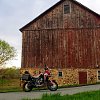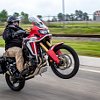Adventure bikes have knobbies.
Right? Or something like that. I’m not sure. I began riding before “ADV bike” was a thing. Perhaps because of that, I always thought every bike was an adventure bike. I mean, I have a lot of adventures. Hell, even my commute is an adventure most days. I don’t have to find a gravel trail to fulfill some marketing dream. As such, I was more than happy to test a leftover Africa Twin that was delivered biased to street work.

Honda delivered this motorcycle for us to use over the summer, and I doubt they had the slightest inkling that not only was I about to use their bike, but I was going to do my damnedest to use it up. I won’t delve into all the specifications of the bike, because you can read many of them in Spurgeon’s first ride of the 2016 version and Kamrad’s shakeout of the new AT. This is last year’s model, but many of the specs are similar or the same. Instead, I’ll tell you this: I think this bike is a wonderful touring mount in its own right. Its off-road capability is just a bonus for the way I’m using this motorcycle right now. For anything gnarly enough for me to feel a need to remove the bags, I’d simply choose a dirt bike. For seeing the sights, packing gear, and keeping Mrs. Lem comfy on the road, the AT is doing just fine. My usage scenario on this is not necessarily the ADV dream, but it is the day-in, day-out reality of the workload placed upon most adventure bikes in North America.

The setup
Our 2018 Africa Twin was delivered with Honda's Dual Clutch Transmission (DCT). I would normally not choose this option (see a full discussion of how it works below), but lately I have actively attempted to force myself into doing things differently than my default set of preferences. It came with optional Honda side cases, optional Honda crash bars, and Dunlop Trailmax D610 tires, which, in spite of the name, are pretty much straight-up street tires. We tossed the OEM bags and mounts and installed a set of Givi Trekker luggage and an SW-Motech topcase mounting plate to make this machine my summer long-hauler. The Givi Trekkers were transformational. There was so much room!
This bike set up in this fashion makes complete sense if one thinks of it as a long-travel sport-tourer, sort of a poor man’s Multistrada. I could go anywhere I liked on the road, and the tires kept me from taking the (now heavily loaded) motorcycle anywhere off-road I should not have gone.
I call it the Dirt Bagger.
How it performs
Honda shipped the AT to our local Honda shop, and I rode it home. At first blush, it was a mild-mannered, softly sprung bike, as likely to offend anyone as I am to join a quilting bee. I was unaware there was a manual-shift mode (like the new Gold Wing has) until Spurgie showed it to me. Previous to that, I had been riding the bike strictly in self-shifting mode. Joe Zito, the ZLA Mechanical Guru, came away with the same thought I did: Shift points come a bit too soon in every mode, but it’s better and better in the sportier settings.

The bike shifts way too early if you’re not deep in the throttle, to the point where pistons will rattle in their bores. There is a big button on the dash that says simply, “G.” I found out that’s for “gravel,” and it firms up the shifts, makin’ ‘em faster, but jerkier. Given that in my car days most of my victims got a shift kit installed in ‘em, I was a big fan of that button — though it did nothing about the shift points themselves.
The bike also “forgot” to take engine load into account occasionally; several times on a steep grade I maintained constant throttle, and though I was not near redline, the bike would upshift. Very irritating, but forgivable. No self-shifting machine can be asked to get this right all the time.
The suspension was like riding around on a birthday cake when I picked up this bike. I mean, all suspensions are soft when they’re enduring the weighty duress that is your Lem, but this one was really taking the worst of the beating. Joe had set the bike up for me, and I was still disappointed. (He did a great job and did things the way he ought to, but as I have described in the past, I have an unorthodox way of getting bikes designed for less-heavy riders to cope with my lard.) He shook his head as I did my own suspension setup, and rightfully so — you won’t find my tips in any reputable suspension tuning guide.

Once I removed all that pesky rebound damping, the Dirt Bagger’s suspension began to perform quite well. The big travel (8.0 inches up front and 8.7 out back) made this bike feel like one hell of a plushy tourer on the street, where it soaked up junky pavement and potholes. Impact force reduction seems to do me a lot of good when I’m racking up mileage. I liked the comfort enough to even dial out some of the rear preload for wheelies comfort. Big ups to Honda for the remote rear preload adjuster. All bikes should have that. It costs extra, and it’s nice to see on a bike.
(As a side note, I have read all the ballyhoo over on advforum.com and elsewhere about the fork wear these bikes are said to exhibit. I haven’t pulled ours apart, but that wear looks reasonable to me. Suspension on, say, a car is not meant to be forever rebuildable. That said, if I was Twin shopping, I’d be looking for a 2018 or later with the Kashima coating, or make sure I picked up a discount on an older bike so I could have the uppers hard anodized or something.)

A nice side effect of getting a suspension to work right is that the brakes start working, too. It’s hard to assess how effective brakes are when you’re pogo-ing about. The brakes on the AT are more than adequate. Being able to turn off the rear ABS is nice for either street antics or (I imagine) dirt antics. One odd thing about a DCT is that the rear brakes also affect shifts, too, because the rear wheel is never uncoupled from the rest of the driveline. It’s not unpleasant, just different.

The powerplant is a lot of fun. The Dirt Bagger’s power is linear and meaty; a very satisfying mill indeed. The power is tractable power, with a strong mid-range punch that tapers as it nears redline. The engine is a parallel-twin thou, sort of a strange animal because it features a 270-degree crank (and a balancer, too). I guess this makes more sense when you realize Honda was shooting to emulate the characteristics of the original V-twin XRV750 Africa Twin.
It feels to me like a cross between a BMW F and R motor in terms of power and “lumpiness,” which makes perfect sense given that this splits the difference between those two twin layouts. I’m personally of the mind that this bike is a bit more at home on tarmac than on any real off-road single-track, but for trail and street duty, the engine has a ton of punch. In light off-road scenarios, that beefy liter power downstairs was sublime, allowing the AT to exploit what I feel is the advantage of all ADV bikes off-road: tractor power for sure-footedly managing terrain. The bikes are large and cumbersome, but all the low-end oomph means you don’t have to worry about feathering clutch and throttle, and can instead use gross muscle movements to help direct the bike over suitable lines.

I started commuting on the AT before long-hauling with it, and it performed admirably on my 70-ish miles each direction. My commute’s a great mix of winding rural roads, loads of highway, and some in-town city riding. The AT was a bundle of fun through all of it. No clutch? No problem. You can leave it in “automatic” shift mode with a few different levels of sportiness, or it’s possible to manually shift the bike via trigger shifters near the left grip. More on this later.

I appreciated the range. A sample round-trip commute with incredibly aggressive riding (speeds largely between 80 and 90 mph; lotsa jackrabbit starts) saw 145 miles from a tank, and I still was showing one bar of fuel left (of five). I’m sure that could be stretched out, too. That 145 miles came from 3.542 gallons of gas, yielding just shy of 41 mpg. I can’t say I’m not impressed. That’s pretty dang good for a bike of this size.
And before I forget to mention it, heat (though subjective) seemed pretty subdued. The bottom of the engine gets pretty warm and my tootsies were sweating on a number of occasions, but heat up near my torso was not even present, even on warmer days.
The DCT
Everyone who asks me about the Dirt Bagger wants to talk about the transmission. It works great. I really have few complaints with it. That said, I think I just prefer manually bangin’ gears. However, the AT certainly was not hard to live with.

The early upshifts I mentioned earlier were a drag, so I spent a lot of time using the trigger shifters in manual-shift mode. Almost all of the control of a conventional trans, no hurty hand.

Especially for low-speed stuck-in-traffic city stuff, this was a pretty nice feature to have. Gear changes were both fast and smooth. Note that this mode holds a gear and will not upshift automatically, but it will auto downshift to prevent stalling at very low speed. I don’t have any plans to do any serious trail riding with the AT, but I’d love to know how that self-shiftin’ slushbox does off the road. I bet it’s a real boon most of the time.
Not so hot parts
My notes have this in there: ***Mention right foot/muffler interference.*** And really, this is a big deal. Spurg and I have both panned manufacturers before for simply not allowing adequate room for feet, and Honda will not emerge unscathed. Spurg wears a size 13. I’m a 12. I think we both tend to rest the balls of our feet on the pegs. Doing that on this bike isn’t a possibility on the right side because the muffler and shield interfere with your foot. Spurg found this to be less of a problem than I did, but we both noticed it. And the footpegs are tiny, which sucks, but Kamrad reports the ones on the current AT are larger.
Unlike Kamrad, I don’t believe that any Africa Twin is “nine out of 10 in terms of being adventure-ready in stock form.” I’d give the AT a… uh, like a four or a five. My bike arrived with optional crash guards on it at my request. They’re probably fine for light tipovers. For actual adventuring, I like a beefy cage (.095-inch wall? Maybe .120-inch?) that protects an adventure machine’s “wings” on the fuel tank, aluminum-skeleton handguards, and a skid plate that will take the abuse, because with Fat Lem in the saddle, I do my best impression of a disc jockey: The hits just keep on comin’! These handguards are plastic and the skid plate is a cookie sheet. That’s actually OK with me; most people are not going to be ripping this through the woods and 95 percent of users are going to do what I am doing with it. So I’m good with the stock setup — just be warned that to me, this bike needs a little more than what Honda blessed it with if you're going to go to the woods.

And Joe Zito pointed something out to me that I could not un-see. The AT’s cam chain tensioner is exceptionally phallic. The right side of the engine looks extremely happy to see me when I walk out to it each morning.

The final sticking point here for me is the factory bags. In 2017, a set of accessory bags keyed to the ignition rang in at $784.75. Now, let me start by saying having one key for the bike and bags is quite nice. Unfortunately, that’s where the nice things I have to say end. The cases feel flimsy and they don’t close solidly, and the little chrome latches can be fiddly. Ultimately, I’m not sure I would fork over eight bones for a set. Happily, you don’t need to. It’s just a bit of a bummer when I see some phenomenal integrated luggage these days. (Kawi and BMW spring to mind immediately.) Compared to the Trekkers Zito spoiled me with, it wasn’t even a comparison.
TL;DR — This bike was closer to my truck in terms of payload than nearly any other bike I’ve ridden.
Final thoughts for now
I like this bike quite a bit. I think the DCT is well implemented, though I’d be interested in trying a conventional-trans machine. This bike is tall, comfy, probably able to go everywhere but the most aggressive single-track, where I’d want a dirt bike anywho, and Mrs. Lem loves it. I would (and have) considered a bike like this as my hauler/commuter/two-wheeled pick-’em-up truck bike. I’d be eyeing up a Yamaha Super Ténéré very hard if I were looking for this because they’re currently heavily discounted and I love shaft drive, but I also am comfortable with the extra lard on that bike. With a tire swap, however, the AT really offers (I think) a pretty reasonable power-to-weight ratio for all but the most serious trail junkie with suspension travel to match. However, I’ll be keeping the street-biased tires on this bike. I can have an adventure anywhere, remember?
I’ll be on this bike for a little while longer. Expect to see it in future Common Tread hijinks.













